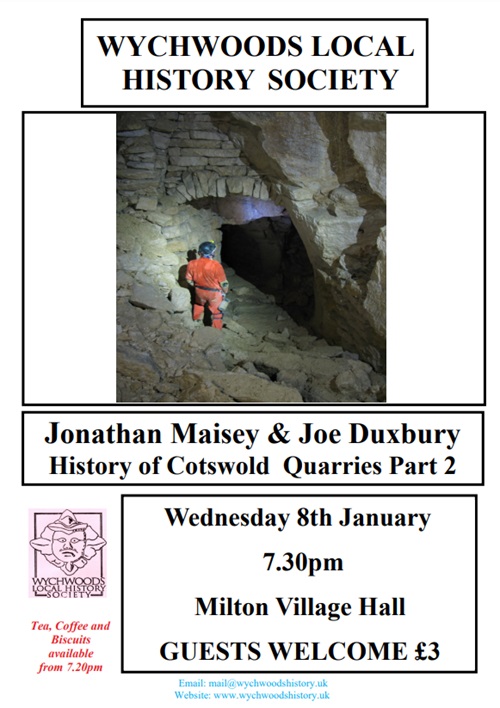
Speakers: Jonathan Maisey and Joe Duxbury
Subject: Cotswold Quarries Part 2
Jonathan Maisey’s 2023 presentation with Joe Duxbury on the Windrush Quarries was particularly well-received and attracted interesting questions and feedback.
Jonathan and Joe were invited back to complete the story of the their work on the Windrush Quarries.
For Jonathan and Joe’s update presentation to their 2023 visit, we had an encouraging turnout of 40+ members and guests for the first talk of the year, so soon after Christmas and New year festivities and with snow still lingering.
After a quick recap on the work and findings of the Gloucestershire Speleological Society for Windrush 1 and 2, Jonathan took us through the highlights of the discoveries and research on areas of the quarries, suitably named Windrush 3 to 5.
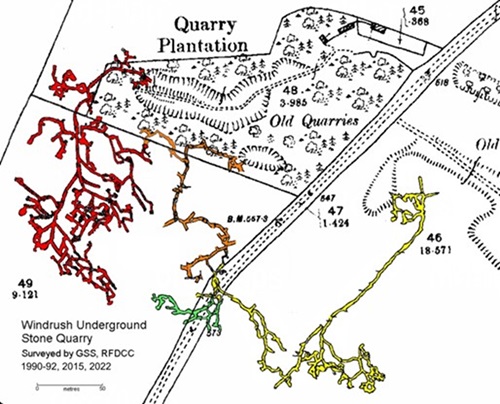
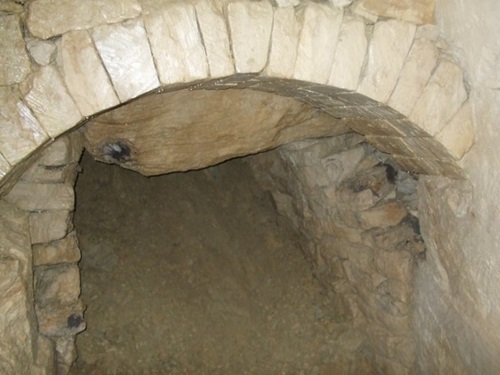
We were reminded how the Windrush Quarries was opened in the strip of Taynton stone that crops out in a continuous band between the river Windrush and the main road past Burford (A40, Oxford to Cheltenham) that rises 150-200 feet above. The quarrymen moved from surface quarrying to underground activity to avoid the need to dig through layers of Hampen Marley Beds, and White Limestone.
Developing the story from the discovery of Windrush 2 and the establishment of the location of the “Windrush Stables” where the horses/ponies used for moving the stone were kept, Jonathan showed the locations of other sections of the quarry complex. These included the 2013 discovery of workings in Windrush 3, and more workings nearby discovered a year later known as Windrush 4, with a final set of workings discovered in 2015 known as Windrush 5 – currently the extent of the known workings of the quarries.
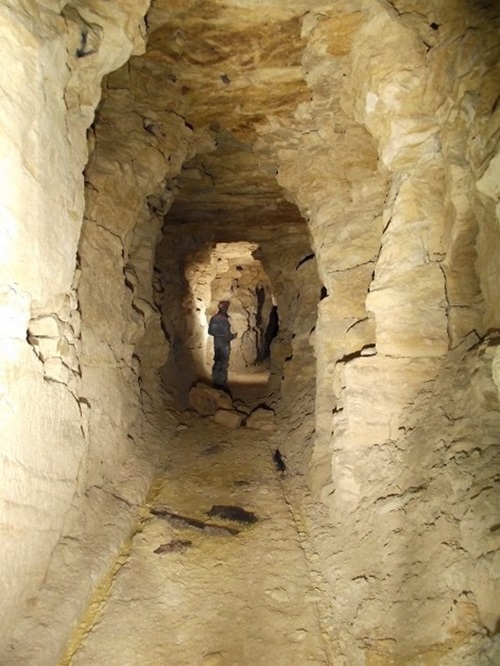
We learned in the Q&A at the end, that in addition to extensive local use, Windrush stone has been used for some of the Oxford Colleges (estimates and accounts from 1716 & 1788 report Windrush stone being selected) and in 1804 replacing inner worn stone in some Oxford colleges as well as the exterior of Oriel Library. It is recorded in 1883 as being used in the inside of St George’s Chapel, Windsor. It was also used for the new Houses of Parliament in 1839.
Not everyone in the hall would share Jonathan and Joe’s passion for crawling through dark narrow spaces, but their enthusiasm and excitement at what they might discover – and the care, of course, in gingerly stepping onto fresh ground to avoid damaging any possible finds – was infectious.
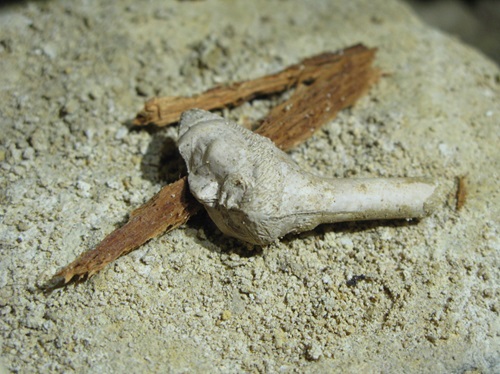
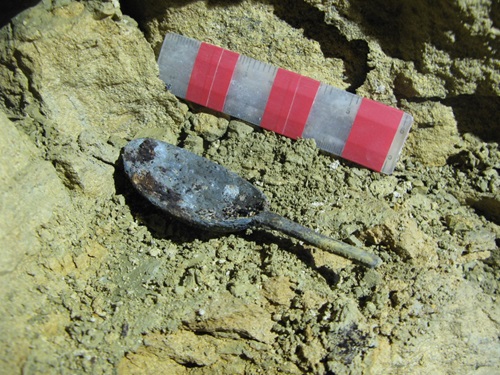
The clues which miners left behind all connect us in a time capsule to the local men who worked these quarries. These included slabs of good stone awaiting transport, the marks along the walls left by the tackle of the horse-drawn carts, carved drainage channels of varying and mysterious purpose, broken clay pipes, old shoes, bits of broken tools, and not least, the graffiti which gives us names and dates of many of those men.
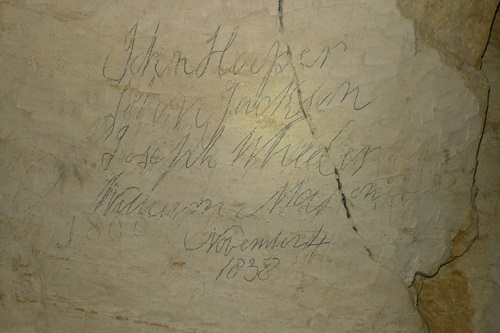
Joe gave us a summary from census records of the numbers of stone masons, stone miners and mason’s labourers which showed a decline from the 1880s. But it seems that at no time were the quarries a major employer of skilled workers. However, the quarries offered an important additional income for landowners, and crucially, gave winter employment for farm workers during the lean months for agriculture.
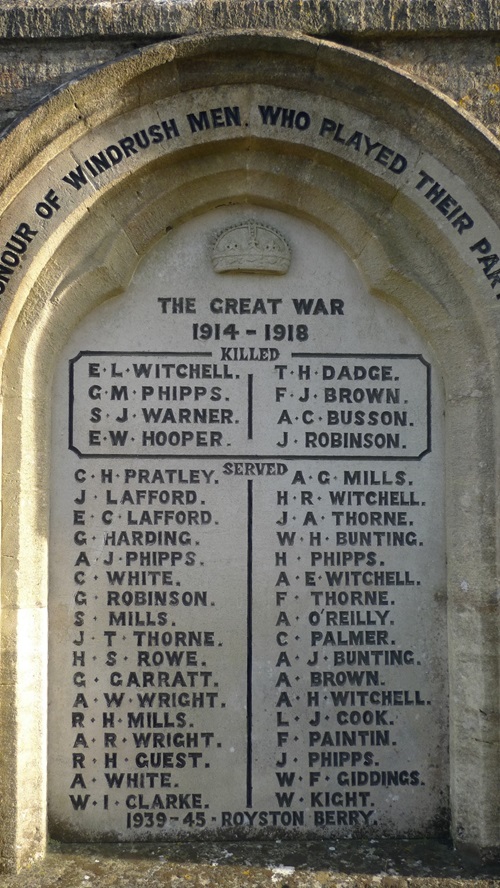
Sadly, the social and economic value of the quarries was finally compromised by the introduction nationwide of new government regulations for mining activity specifically geared to the larger and vital national scale mines in the UK. An unintended consequence of such legislation was to make such smaller enterprises as the Windrush Mines uneconomical due to the prohibitive costs involved.
Our evening ended with some very engaging questions from many of the group, and particularly focussed around the possibility of finding descendants of the named miners, including any connections with workers employed by Groves in Milton.
About Jonathan and Joe
Jonathan Maisey has been involved with caving and the Gloucester Speleological Society (GSS) since 1983 and has undertaken a wide range of caving/mining trips across the UK, France and the USA. Nowadays, his underground interest is more towards mines rather than caves. Of particular interest are the underground stone quarries of the Cotswolds and ongoing work to uncover some of these lost mines. Jonathan has also been a member of the Gloucestershire Cave Rescue Group for 30+ years.
Joe Duxbury has been caving for nearly 60 years, and has been a member of GSS for about 40. He has visited caves throughout Europe and North America. Mines and underground quarries are just as interesting to him as caves, and Windrush has proved to be a fascinating project over the years.

